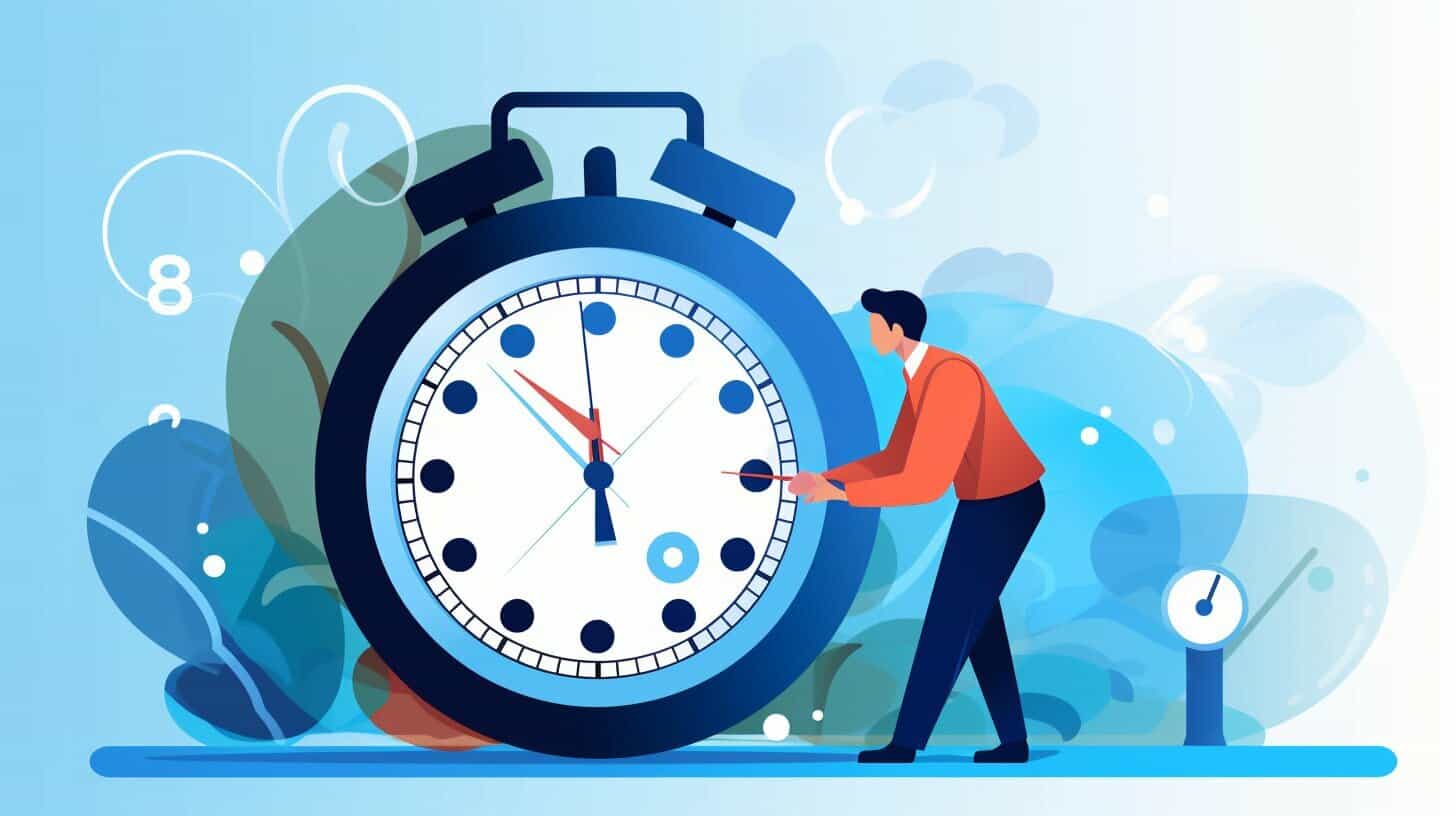As a professional in the workforce, I understand the importance of efficiency and productivity. Time is a valuable resource, and wasting it can negatively impact our work and personal life. That is why I want to introduce you to the concept of a time study and its potential to improve your efficiency.
A time study is a method used to measure how long it takes to complete a task or activity. It is a valuable tool for businesses to identify inefficiencies, optimize processes, and improve productivity. In this article, I will guide you through the steps of conducting a time study and how it can benefit you and your workplace. So, lets take a look at how to conduct a time study.
Key Takeaways:
- Understanding the importance of a time study for improving efficiency and productivity in the workplace.
- The different techniques and methods used in conducting a time study, including time and motion study and work measurement techniques.
Understanding Time Study: Definition and Benefits
As a professional copywriting journalist, I understand the importance of improving efficiency and productivity in the workplace. Conducting a time study is a valuable tool for achieving these goals. A time study is a process of determining the time required to perform a specific task or activity. By analyzing the results of a time study, organizations can identify inefficiencies, improve processes, and ultimately save time and money.
The benefits of a time study go beyond cost savings. It can also help identify areas for improvement in employee performance, reduce work-related accidents, and ensure compliance with safety regulations. A time study can even help organizations make informed decisions about staffing levels, equipment needs, and future investments.
Before conducting a time study, it is important to have a clear understanding of the methodology and procedure involved. This includes selecting the appropriate time and motion study techniques, data collection methods, and analysis tools. By following a disciplined and systematic approach, organizations can obtain accurate and reliable results.
Preparing for a Time Study: Setting Objectives and Goals
Before conducting a time study, it’s crucial to set clear objectives and goals. This will help you stay focused during the study and ensure that the data you collect is relevant and useful. To begin, ask yourself: what do you want to achieve through the time study? Are you looking to reduce the time it takes to complete a specific task? Do you want to identify bottlenecks in your workflow? Or are you simply looking to gain a better understanding of how your team spends their time?
Once you have identified your objectives, it’s time to develop a plan for achieving them. This may involve creating a time study template or utilizing time study analysis software to streamline the data collection process. Consider the tools and resources available to you, and choose the ones that best suit your needs.
| Tip: | When setting objectives, it’s important to involve all relevant team members in the decision-making process. This will help ensure that everyone is on the same page and invested in the success of the time study. |
|---|
Finally, be sure to communicate your objectives and goals clearly to your team. This will help them understand the purpose of the time study and the role they play in its success. By working together towards a common goal, you’ll be well on your way to achieving greater efficiency and productivity in your workplace.

Choosing the Right Methodology: Time and Motion Study Techniques
Time and motion study techniques are essential in conducting an efficient and accurate time study. There are various methodologies used in time and motion studies, and selecting the right one depends on the specific workplace scenario.
Methods for Performing Time and Motion Study
There are different methods for performing a time and motion study, and each has its own purpose and advantages.
| Method | Purpose |
|---|---|
| Stopwatch Time Study | To measure the time taken to complete a task or process. |
| Motion Study | To identify and eliminate unnecessary movements in a process. |
| Predetermined Motion Time Study | To measure the time taken to complete a task using predetermined time values. |
Before selecting a methodology, it is important to consider various factors such as the level of detail required, the nature of the tasks being studied, and the resources available.
Choosing the Right Methodology
To choose the right methodology, it is important to understand the purpose of each method and their advantages.
Stopwatch Time Study: This method is suitable for tasks that are repetitive and have a predictable sequence of motions. It is easy to perform and provides accurate data. However, it does not consider the variability in human performance and may not capture the nuances of complex tasks.
Motion Study: This method is suitable for tasks that involve a high level of physical movements. It is effective in identifying and eliminating unnecessary movements, reducing fatigue, and improving productivity. However, it may not capture other factors that affect the performance of a task, such as mental load and decision-making.
Predetermined Motion Time Study: This method is suitable for tasks that have a set sequence of motions and are repeated frequently. It uses predetermined time values for each motion and provides accurate and consistent data. However, it does not consider the variability in human performance and may not capture the nuances of complex tasks.
Selecting the right methodology depends on the nature and complexity of the task being studied, as well as the resources available. A combination of different methodologies may also be used to obtain a more comprehensive understanding of the task.

Collecting Data: Time Study Data Collection Methods
Accurate and reliable data collection is essential in conducting a successful time study. There are several data collection methods that can be used, depending on the workplace scenario and the type of data required.
Direct Observation
The most commonly used data collection method in a time study is direct observation. This involves observing the work being done and recording the time taken to complete each task. This method allows for the collection of detailed data on the entire work process, including start and stop times, and any breaks taken.
Time Log Sheets
Another data collection method is the use of time log sheets. This involves employees recording their activities and the time taken during the workday. Time log sheets are useful for collecting data on tasks that are done sporadically or on a less frequent basis.
Technology-based Tools
Advancements in technology have made it possible to collect data using various software and tools. For example, time-tracking software can be used to collect data on how employees spend their time on the computer. Similarly, wearable technology, such as smartwatches, can collect data on an individual’s physical movements and activity levels.
Regardless of the data collection method used, it is important to ensure that the data collected is accurate and representative of typical work activities.
Conducting the Time Study: Step-by-Step Process
Now that I have my objectives and goals set, it’s time to start the actual time study process. The following steps will guide me through this process:
- Select a representative sample: I will select a sample that is representative of the work being done in the workplace. This will ensure that the data collected is accurate and reliable.
- Create an observation plan: I will create a plan for observing the selected sample. This plan should include the time and location of the observations, as well as the specific tasks that will be observed.
- Conduct observations: I will observe the selected sample, recording the time taken to complete each task, as well as any other relevant data.
- Document findings: I will carefully document the findings of the time study. This will include the time taken to complete each task, as well as any other relevant observations made during the study.
It’s important to remember that these steps should be followed carefully and accurately in order to gather accurate and reliable data. Any errors or inaccuracies in the data could lead to incorrect conclusions, which could ultimately impact the overall effectiveness of the time study.

Analyzing Time Study Data: Techniques and Tools
Once the data collection phase of a time study is complete, the next step is to analyze the data to identify areas for improvement. There are several techniques and tools available to help with this process.
Statistical analysis software: This type of software can help to identify patterns and trends in the data. It can also perform complex calculations to determine averages, standard deviations, and other statistical measures.
Productivity metrics: These metrics provide insight into how efficiently tasks are being completed. They can include metrics such as cycle time, throughput, and work-in-progress.
When analyzing time study data, it is important to look for patterns and trends that may indicate areas for improvement. For example, if a certain task consistently takes longer than expected, it may be worthwhile to investigate the root cause of the delay and consider implementing changes to improve efficiency.
“Analyzing time study data can provide valuable insights into inefficiencies and areas for improvement in the workplace.”
It is also important to consider the context in which the data was collected. For example, if the data was collected during a particularly busy period, it may not be representative of typical performance. Taking this into account can help to ensure that any changes made based on the analysis of the data are appropriate and effective.
Overall, analyzing time study data can provide valuable insights into inefficiencies and areas for improvement in the workplace. By using the right tools and techniques, and carefully considering the context in which the data was collected, it is possible to identify opportunities for improvement and make meaningful changes that can lead to increased efficiency and productivity.

Interpreting Results: Identifying Inefficiencies and Improvement Opportunities
Now that I have collected and analyzed the data from my time study, it’s time to interpret the results. My main goal is to identify inefficiencies and improvement opportunities in the workplace, so that I can implement changes that will increase efficiency and productivity.
One of the first things I need to do is look for patterns in the data. Are there any tasks that consistently take longer than they should? Are there any employees who are consistently slower than others? These patterns can help me pinpoint areas where improvements can be made.
It’s important to not just focus on the results themselves, but also to understand the underlying causes of the inefficiencies. For example, if a task takes longer than it should because of a faulty machine, simply speeding up the employee won’t solve the problem. Instead, I need to address the root cause by repairing or replacing the machine.
I can also use work measurement techniques to identify bottlenecks in the workflow. This can help me identify areas where a small change could have a big impact on overall efficiency.
Finally, I need to prioritize the improvement opportunities based on their potential impact and feasibility. Some changes may require significant investment or a long time to implement, while others may be quick and easy to implement but have a smaller impact. By focusing on the most impactful and feasible changes first, I can maximize the efficiency gains from my time study.
Overall, interpreting the results of my time study is a crucial step in identifying inefficiencies and improvement opportunities in the workplace. By understanding the underlying causes of inefficiencies and prioritizing improvement opportunities based on their potential impact and feasibility, I can implement changes that will increase efficiency and productivity in the long run.
Implementing Changes: Strategies for Improving Efficiency
Now that I have analyzed the data and identified inefficiencies in my workplace, it’s time to implement changes that will lead to improved efficiency.
One strategy that has proven effective is process optimization. By reevaluating current processes, we can identify steps that are unnecessary or redundant and streamline the overall workflow. This can significantly reduce the amount of time and resources required to complete tasks.
Another important aspect is task allocation. By assigning tasks to individuals based on their skills and expertise, we can ensure that every task is completed efficiently and effectively. Clear communication of roles and responsibilities can also minimize confusion and eliminate duplication of effort.
Training programs are another effective way to improve efficiency. By investing in employee training, we can ensure that all staff members are equipped with the necessary skills and knowledge to complete tasks efficiently. This can also increase job satisfaction and motivation.
It is important to continuously monitor and evaluate the effectiveness of any changes made based on the time study results. Regular feedback mechanisms and evaluation processes need to be established to ensure that any improvements are sustained and further opportunities for optimization are identified.
By implementing these changes and continually striving for improvement, we can create a culture of efficiency and productivity that benefits both the organization and its employees.

Monitoring and Continuous Improvement: Sustaining Efficiency Gains
After implementing changes based on the findings of a time study, monitoring and continuous improvement are crucial for sustaining efficiency gains. It is essential to establish feedback mechanisms and regularly evaluate processes to ensure continued success.
One effective way to monitor efficiency is through productivity metrics. These metrics can track progress over time and identify any areas where improvement is needed. It is important to establish a baseline measurement before implementing changes and compare the results after changes have been made.
Regular evaluations and audits can also help to sustain efficiency gains. This involves reviewing processes and procedures to ensure they are still effective and identifying any new areas for improvement. The feedback received from employees and stakeholders is also valuable in identifying any issues or inefficiencies that may not have been previously identified.
Training programs should be implemented to maintain efficiency gains, especially for new employees or when changes have been made to existing processes. This ensures everyone is aware of the new procedures and can perform tasks effectively.
Overall, monitoring and continuous improvement are critical components of sustaining efficiency gains achieved through a time study. By establishing feedback mechanisms, regularly evaluating processes, and implementing training programs, efficiency gains can be maintained and improved upon over time.
Case Studies: Real-Life Examples of Successful Time Studies
In this section, I want to share with you some real-life examples of successful time studies. These cases demonstrate the powerful impact that a thorough time study can have on efficiency and productivity in different industries and organizations.
Case Study 1: Manufacturing Industry
A manufacturing company was struggling to meet demand for its products due to its inefficient production processes. By conducting a time study, the company was able to identify bottlenecks in the assembly line and reorganize workstations to optimize the workflow. The result was a 25% increase in production output and a significant reduction in waste.
Case Study 2: Healthcare Industry
A hospital was experiencing long wait times for patients due to inefficient patient flow and scheduling processes. By conducting a time study, the hospital identified areas for improvement, such as reducing wait times for diagnostic tests and streamlining patient check-in procedures. The result was a 30% decrease in wait times and improved patient satisfaction.
Case Study 3: Service Industry
A consulting firm was struggling to manage workloads and maintain profitability due to inefficient time management practices. By conducting a time study, the firm was able to identify time-wasting activities, such as checking emails excessively and unnecessary meetings, and implement time-saving strategies, such as batching emails and using project management software. The result was a 20% increase in billable hours and improved employee satisfaction.
These case studies highlight the versatility and impact of time studies in different industries and settings. By taking the time to conduct a thorough and accurate time study, organizations can identify inefficiencies and improvement opportunities, ultimately leading to increased efficiency, productivity, and profitability.
Conclusion on How To Conduct A Time Study
In conclusion, conducting a time study can be a powerful tool for improving efficiency and productivity in the workplace. By using time study techniques, organizations can identify inefficiencies and implement strategies to drive improvements in performance.
As I’ve discussed throughout this article, there are various steps involved in conducting a successful time study. It starts with setting clear objectives and selecting the appropriate methodology. From there, data collection and analysis are key components. Interpreting the results and initiating changes are also crucial to achieving meaningful outcomes. Finally, monitoring and continuous improvement are essential for sustaining efficiency gains over time.
Don’t be afraid to take action and implement time study techniques in your own workplace. By using the step-by-step guidance provided in this article, you can develop a deeper understanding of your organization’s productivity and make meaningful improvements to your processes. Best of luck on your journey to enhanced efficiency and productivity!
FAQ on How To Conduct A Time Study
Q: What is a time study?
A: A time study is a systematic process of observing and measuring the time required to perform specific tasks or activities. It helps in analyzing work processes, identifying inefficiencies, and improving overall productivity and efficiency in the workplace.
Q: Why is a time study important?
A: A time study is important because it provides valuable insights into the way work is performed. It helps in identifying bottlenecks, eliminating wasteful activities, and optimizing work processes. By conducting a time study, organizations can improve efficiency, reduce costs, and increase productivity.
Q: What are the different techniques used in a time study?
A: There are various techniques used in a time study, such as time and motion study, work sampling, and predetermined motion time systems. Each technique has its own purpose and can be used depending on the specific needs and requirements of the organization.
Q: How do I prepare for a time study?
A: To prepare for a time study, it is important to set clear objectives and goals. Define what you want to achieve through the time study and plan the necessary resources and tools required. You can also make use of time study templates and analysis software to streamline the process.
Q: How do I choose the right methodology for a time study?
A: Choosing the right methodology for a time study depends on various factors, such as the nature of the work, the level of precision required, and the available resources. It is important to understand the purpose of each methodology and select the most appropriate one for your specific workplace scenario.
Q: What are the different data collection methods used in a time study?
A: There are several data collection methods used in a time study, including direct observation, time log sheets, and technology-based tools. Each method has its own advantages and disadvantages, and the choice depends on the accuracy and reliability required for the study.
Q: What is the step-by-step process of conducting a time study?
A: The step-by-step process of conducting a time study involves selecting a representative sample, conducting observations, documenting the findings, and analyzing the data. It is important to follow a structured approach to ensure accurate results and meaningful insights.
Q: What techniques and tools are used for analyzing time study data?
A: Various techniques and tools can be used for analyzing time study data, including statistical analysis software and productivity metrics. These tools provide valuable insights into the efficiency of work processes, identify potential bottlenecks, and help in making data-driven decisions for improvement.
Q: How do I interpret time study results?
A: Interpreting time study results involves analyzing the data and identifying inefficiencies and improvement opportunities. It is important to understand the underlying causes of inefficiencies and develop strategies to address them effectively. This can lead to significant improvements in productivity and efficiency.
Q: What strategies can be used to improve efficiency based on time study findings?
A: Based on time study findings, organizations can implement strategies such as process optimization, task allocation, and training programs. These strategies aim to eliminate wasteful activities, streamline work processes, and enhance the skills of employees to improve overall efficiency in the workplace.
Q: How do I sustain efficiency gains achieved through a time study?
A: Sustaining efficiency gains requires continuous monitoring and improvement. Establishing feedback mechanisms, conducting regular evaluations, and encouraging employee involvement are important aspects of sustaining efficiency in the long term. It is a continuous process that requires commitment and dedication from the organization.
Q: Can you provide examples of successful time studies?
A: Yes, real-life case studies can showcase successful time study implementations. These examples highlight the impact of time studies on productivity and efficiency in specific industries and organizations. They serve as inspiration and provide insights into the benefits of conducting a time study.





Leave a Reply